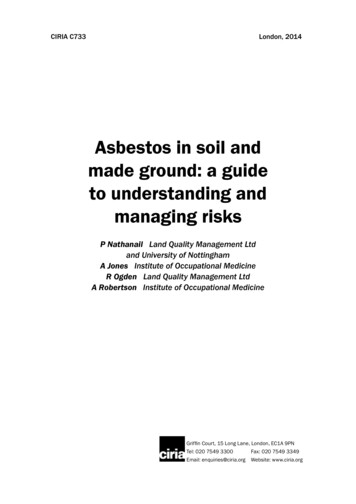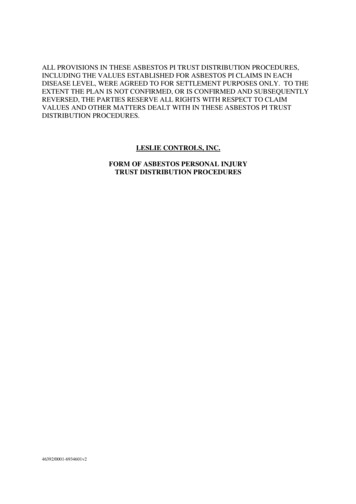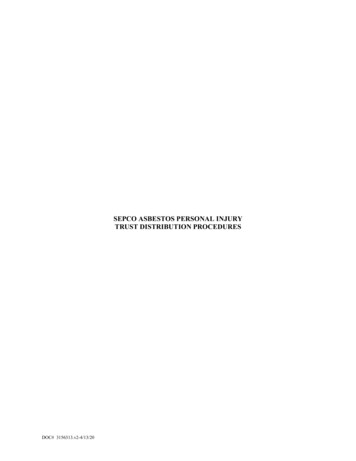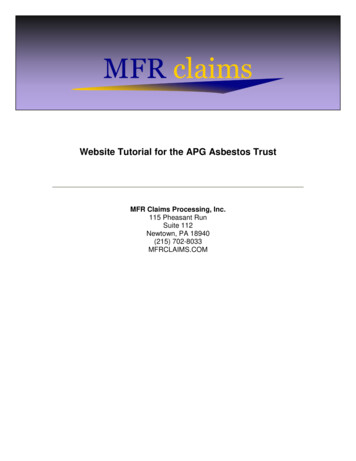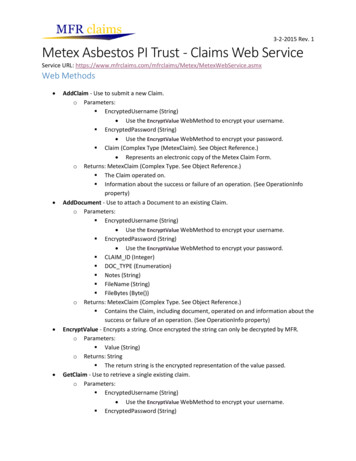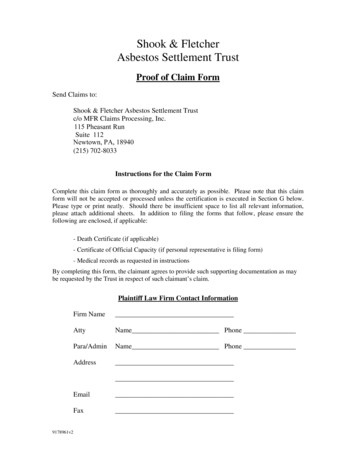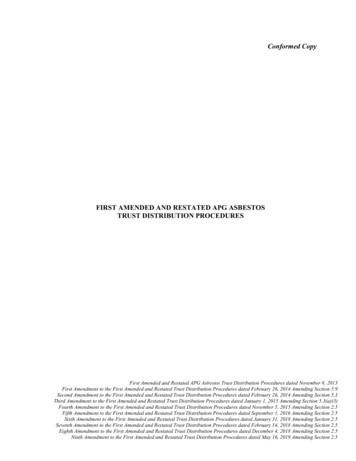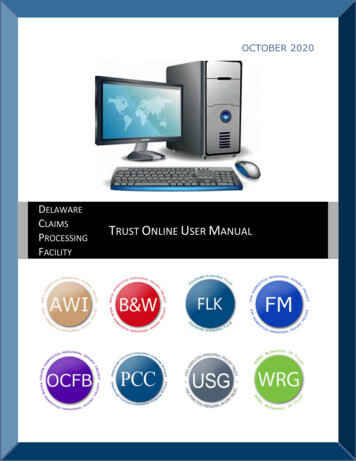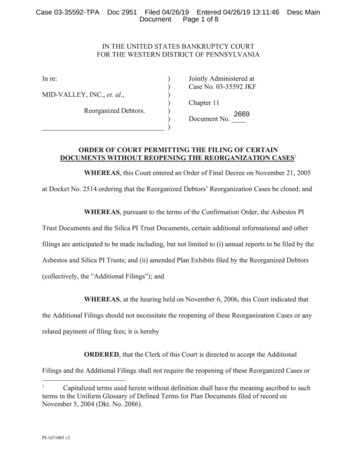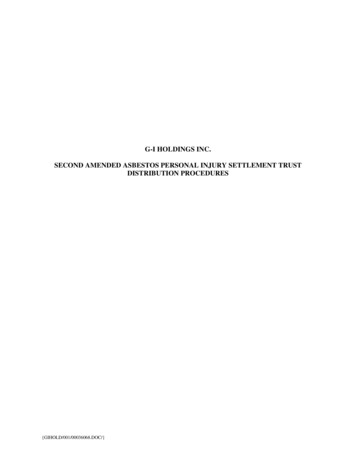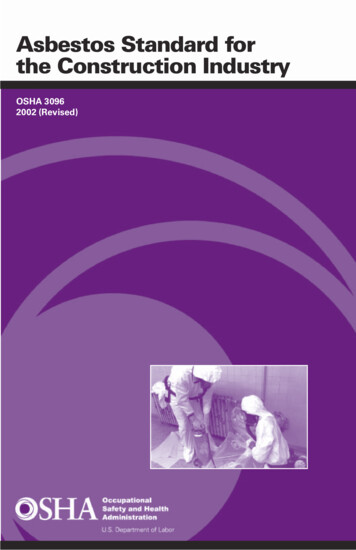
Transcription
Asbestos Standard forthe Construction IndustryOSHA 30962002 (Revised)
This informational booklet providesa generic, non-exhaustive overview of aparticular topic related to OSHA standards.It does not alter or determine complianceresponsibilities in OSHA standards or theOccupational Safety and Health Act of 1970.Because interpretations and enforcementpolicy may change over time, you shouldconsult current administrative interpretationsand decisions by the Occupational Safety andHealth Review Commission and the Courtsfor additional guidance on OSHA compliancerequirements.This publication is in the public domain andmay be reproduced, fully or partially, withoutpermission. Source credit is requested butnot required.This information is available to sensoryimpaired individuals upon request.Voice phone: (202) 693–1999;Teletypewriter (TTY) number: (877) 889–5627.
Asbestos Standardfor the ConstructionIndustryU.S. Department of LaborElaine L. Chao, SecretaryOccupational Safety and Health AdministrationJohn L. Henshaw, Assistant SecretaryOSHA 30962002 (Revised)iii
iv
ContentsIntroductionWhat is asbestos? . 1What are the dangers of asbestos exposure? . 1What construction activities does this booklet cover? . 1Provisions of the OSHA StandardWhat is work classification? . 3What is the permissible exposure limit for asbestos? . 4Which asbestos operations must employersmonitor and assess? . 4What is the function of a competent person? . 4What is an initial exposure assessment? . 5What is a negative exposure assessment? . 6Are employers required to perform exposure monitoring? . 6When must employers conduct periodic monitoring? . 7Is additional monitoring ever needed? . 8Are employers required to establish medicalsurveillance programs for employees? . 8Do employers have to keep any employee records? . 10What is a regulated area? . 12Who is responsible for communicatingasbestos hazards at worksites? . 14Does the OSHA standard require theposting of warning signs? . 15Must employers provide asbestos warning labels? . 16Do employers have to train employeesregarding asbestos exposure? . 16v
Methods of ComplianceWhat methods must employers use to controlasbestos exposure levels? . 19What are the compliance requirements for Class I work? . 20What are the compliance requirements for Class II work? . 23What are the compliance requirements for Class III work? . 27What are the compliance requirements for Class IV work? . 28Does the competent person have duties thatapply to more than one work class? . 28What does the OSHA standard requireconcerning respirators? . 29Do employers have to provide protectiveclothing for employees? . 31What are the hygiene-related requirements for employeesperforming Class I asbestos work involving more than25 linear feet or 10 square feet of thermal system insulationor surfacing ACM or PACM? . 32What are the hygiene-related requirements for employeesperforming other Class I asbestos work and Class II and IIIasbestos work where exposures exceed a PEL or where anegative exposure assessment has not been produced? . 34What are the hygiene-related requirementsfor employees performing Class IV work? . 35What are an employer’s housekeeping responsibilities? . 35Quick Reference of Provisions by Work Class . 37OSHA AssistanceWhat are safety and health systemmanagement guidelines? . 43What are state programs? . 44How do I obtain consultation services? . 44vi
What are Voluntary Protection Programs (VPPs)? . 45What is the Strategic Partnership Program? . 46Does OSHA offer training and education? . 46Does OSHA provide any information electronically? . 47How do I learn more about related OSHA publications? . 48How do I contact OSHA about emergencies, complaints,or further assistance? . 48OSHA Office DirectoryOSHA Regional Offices . 49OSHA Area Offices . 50OSHA-Approved State Plans . 53OSHA Consultation Projects . 56vii
viii
IntroductionWhat is asbestos?Asbestos is the generic term for a group of naturallyoccurring, fibrous minerals with high tensile strength,flexibility, and resistance to heat, chemicals, and electricity.In the construction industry, asbestos is found in installedproducts such as sprayed-on fireproofing, pipe insulation,floor tiles, cement pipe and sheet, roofing felts and shingles,ceiling tiles, fire-resistant drywall, drywall joint compounds,and acoustical products. Because very few asbestoscontaining products are being installed today, most workerexposures occur during the removal of asbestos and therenovation and maintenance of buildings and structurescontaining asbestos.What are the dangers ofasbestos exposure?Asbestos fibers enter the body when a person inhalesor ingests airborne particles that become embedded in thetissues of the respiratory or digestive systems. Exposureto asbestos can cause disabling or fatal diseases such asasbestosis, an emphysema-like condition; lung cancer;mesothelioma, a cancerous tumor that spreads rapidly inthe cells of membranes covering the lungs and body organs;and gastrointestinal cancer. The symptoms of these diseasesgenerally do not appear for 20 or more years after initialexposure.What construction activitiesdoes this booklet cover?The asbestos standard for the construction industry(29 CFR Part 1926.1101, see www.osha.gov) regulatesasbestos exposure for the following activities: Demolishing or salvaging structures where asbestos ispresent.1
Removing or encapsulating asbestos-containing material(ACM).Constructing, altering, repairing, maintaining, orrenovating asbestos-containing structures or substrates. Installing asbestos-containing products. Cleaning up asbestos spills/emergencies. Transporting, disposing, storing, containing, andhousekeeping involving asbestos or asbestos-containingproducts on a construction site.Note: The standard does not apply to asbestos-containingasphalt roof coatings, cements, and mastics.2
Provisions ofthe OSHA StandardOSHA has established strict exposure limits andrequirements for exposure assessment, medical surveillance,recordkeeping, competent persons, regulated areas, andhazard communication.What is work classification?The OSHA standard establishes a classification systemfor asbestos construction work that spells out mandatory,simple, technological work practices that employers mustfollow to reduce worker exposures. Under this system, thefollowing four classes of construction work are matchedwith increasingly stringent control requirements: Class I asbestos work is the most potentially hazardousclass of asbestos jobs. This work involves the removalof asbestos-containing thermal system insulation andsprayed-on or troweled-on surfacing materials. Employersmust presume that thermal system insulation and surfacingmaterial found in pre-1981 construction is ACM. Thatpresumption, however, is rebuttable. If you believe thatthe surfacing material or thermal system insulation is notACM, the OSHA standard specifies the means that youmust use to rebut that presumption. Thermal systeminsulation includes ACM applied to pipes, boilers, tanks,ducts, or other structural components to prevent heat lossor gain. Surfacing materials include decorative plaster onceilings and walls; acoustical materials on decking, walls,and ceilings; and fireproofing on structural members.Class II work includes the removal of other types of ACMthat are not thermal system insulation such as resilientflooring and roofing materials. Examples of Class II workinclude removal of asbestos-containing floor or ceiling tiles,siding, roofing, or transite panels.Class III asbestos work includes repair and maintenanceoperations where ACM or presumed ACM (PACM) aredisturbed.3
Class IV work includes custodial activities where employeesclean up asbestos-containing waste and debris produced byconstruction, maintenance, or repair activities. This workinvolves cleaning dust-contaminated surfaces, vacuumingcontaminated carpets, mopping floors, and cleaning upACM or PACM from thermal system insulation orsurfacing material.What is the permissibleexposure limit for asbestos?Employers must ensure that no employee is exposed to anairborne concentration of asbestos in excess of 0.1 f/cc as an8-hour time-weighted average (TWA). In addition, employeesmust not be exposed to an airborne concentration of asbestosin excess of 1 f/cc as averaged over a sampling period of30 minutes.Which asbestos operations mustemployers monitor and assess?Employers must assess all asbestos operations for thepotential to generate airborne fibers, and use exposuremonitoring data to assess employee exposures. You must alsodesignate a competent person to help ensure the safety andhealth of your workers.What is the function of acompetent person?On all construction sites with asbestos operations,employers must designate a competent person—one whocan identify asbestos hazards in the workplace and has theauthority to correct them. This person must be qualified andauthorized to ensure worker safety and health as requiredby Subpart C, General Safety and Health Provisionsfor Construction (29 CFR Part 1926.20). Under these4
requirements for safety and health prevention programs, thecompetent person must frequently inspect job sites, materials,and equipment.The competent person must attend a comprehensivetraining course for contractors and supervisors certified bythe U.S. Environmental Protection Agency (EPA) or a stateapproved training provider, or a complete a course that isequivalent in length and content.For Class III and IV asbestos work, training must includea course equivalent in length, stringency, and content to the16-hour Operations and Maintenance course developed byEPA for maintenance and custodial workers. For morespecific information, see 40 CFR Part 763.92(a)(2).What is an initial exposure assessment?To determine expected exposures, a competent personmust perform an initial exposure assessment to assessexposures immediately before or as the operation begins.This person must perform the assessment in time to complywith all standard requirements triggered by exposure dataor the lack of a negative exposure assessment and to providethe necessary information to ensure all control systemsare appropriate and work properly. A negative exposureassessment demonstrates that employee exposure duringan operation is consistently below the permissible exposurelimit (PEL).The initial exposure assessment must be based on thefollowing criteria: Results of employee exposure monitoring, unless a negativeexposure assessment has been made; andObservations, information, or calculations indicatingemployee exposure to asbestos, including any previousmonitoring.5
For Class I asbestos work, until employers document thatemployees will not be exposed in excess of the 8-hour TWAPEL and short-term exposure limit STEL, employers mustassume that employee exposures are above those limits.What is a negative exposure assessment?For any specific asbestos job that trained employeesperform, employers may show that exposures will be belowthe PELs (i.e., negative exposure assessment) through thefollowing: Objective data demonstrating that ACM, or activitiesinvolving it, cannot release airborne fibers in excess of the8-hour TWA PEL or STEL;Exposure data obtained within the past 12 months fromprior monitoring of work operations closely resembling theemployer’s current work operations (the work operationsthat were previously monitored must have been conductedby employees whose training and experience were no moreextensive than that of current employees, and the data mustshow a high degree of certainty that employee exposureswill not exceed the 8-hour TWA PEL or STEL under currentconditions); orCurrent initial exposure monitoring that used breathingzone air samples representing the 8-hour TWA and 30minute short-term exposures for each employee in thoseoperations most likely to result in exposures over the 8-hourTWA PEL for the entire asbestos job.Are employers required to performexposure monitoring?Yes. Employers must determine employee exposuremeasurements from breathing zone air samples representingthe 8-hour TWA and 30-minute short-term exposures foreach employee.6
Employers must take one or more samples representingfull-shift exposure to determine the 8-hour TWA exposurein each work area. To determine short-term employeeexposures, you must take one or more samples representing30-minute exposures for the operations most likely to exposeemployees above the excursion limit in each work area.You must also allow affected employees and theirdesignated representatives to observe any employee exposuremonitoring. When observation requires entry into a regulatedarea, you must provide and require the use of protectiveclothing and equipment.When must employers conductperiodic monitoring?For Class I and II jobs, employers must conductmonitoring daily that is representative of each employeeworking in a regulated area, unless you have produced anegative exposure assessment for the entire operation andnothing has changed. When all employees use supplied-airrespirators operated in positive-pressure mode, however, youmay discontinue daily monitoring. When employees performClass I work using control methods not recommended in thestandard, you must continue daily monitoring even whenemployees use supplied-air respirators.For operations other than Class I and II, employers mustmonitor all work where exposures can possibly exceed thePEL often enough to validate the exposure prediction.If periodic monitoring shows that certain employeeexposures are below the 8-hour TWA PEL and the STEL,you may discontinue monitoring these employees’ exposures.7
Is additional monitoring ever needed?Changes in processes, control equipment, personnel,or work practices that could result in new or additionalexposures above the 8-hour TWA PEL or STEL requireadditional monitoring regardless of a previous negativeexposure assessment for a specific job.Are employers required to establishmedical surveillance programs foremployees?It depends. Employers must provide a medical surveillanceprogram for all employees who do the following: Engage in Class I, II, or III work or are exposed at orabove the PEL or STEL for a combined total of 30 or moredays per year; orWear negative-pressure respirators.In addition, a licensed physician must perform or superviseall medical exams and procedures that you provide at no costto your employees and at a reasonable time.Employers must make medical exams and consultationsavailable to employees as follows: Prior to employee assignment to an area where negativepressure respirators are worn;Within 10 working days after the 30th day of combinedengagement in Class I, II, and III work and exposure ator above a PEL, and at least annually thereafter; andWhen an examining physician suggests them morefrequently.If an employee was examined within the past 12 monthsand that exam meets the criteria of the standard, however,another medical exam is not required.8
Medical exams must include the following: Medical and work histories;Completion of a standardized questionnaire with the initialexam (see 29 CFR Part 1926.1101, Appendix D, Part 1)and an abbreviated standardized questionnaire with annualexams (see 29 CFR Part 1926.1101, Appendix D, Part 2);Physical exam focusing on the pulmonary andgastrointestinal systems; andAny other exams or tests deemed necessary by theexamining physician.Employers must provide the examining physician withthe following: Copy of OSHA’s asbestos standard and its appendices D,E, and I;Description of the affected employee’s duties relating toexposure;Employee’s representative exposure level or anticipatedexposure level;Description of any personal protective equipment andrespiratory equipment used; andInformation from previous medical exams not otherwiseavailable.It is the employer’s responsibility to obtain the physician’swritten opinion containing results of the medical exam as wellas the following information: Any medical conditions of the employee that increase healthrisks from asbestos exposure.Any recommended limitations on the employee orprotective equipment used.9
A statement that the employee has been informed of theresults of the medical exam and any medical conditionsresulting from asbestos exposure.A statement that the employee has been informed of theincreased risk of lung cancer from the combined effect ofsmoking and asbestos exposure.Note: A physician’s written opinion must not revealspecific findings or diagnoses unrelated to occupationalexposure to asbestos. You must provide a copy of thephysician’s written opinion to the employee involved within30 days after receipt.Do employers have to keepany employee records?Yes. Employers must maintain employee recordsconcerning objective data, exposure monitoring, and medicalsurveillance.If using objective data to demonstrate that productsmade from or containing asbestos cannot release fibers inconcentrations at or above the PEL or STEL, employers mustkeep an accurate record for as long as it is relied on andinclude the following information: Exempt products. Objective data source. Testing protocol, test results, and analysis of the materialfor release of asbestos.Exempt operation and support data descriptions.Relevant data for operations, materials, processes, oremployee exposures.10
Employers must keep records of all employee exposuremonitoring for at least 30 years, including followinginformation: Date of measurement. Operation involving asbestos exposure that you monitored. Methods of sampling and analysis that you used andevidence of their accuracy. Number, duration, and results of samples taken. Type of protective devices worn. Name, social security number, and exposures of theemployees involved.Employers must also make exposure records availablewhen requested to affected employees, former employees,their designated representatives, and/or OSHA’s AssistantSecretary.In addition to retaining a copy of the information providedto the examining physician, employers must keep all medicalsurveillance records for the duration of an employee
Asbestos is the generic term for a group of naturally occurring, fibrous minerals with high tensile strength, flexibility, and resistance to heat, chemicals, and electricity. In the construction industry, asbestos is found in installed p


